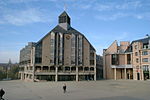Musée Hergé

The Musée Hergé, or Hergé Museum, is a museum in Louvain-la-Neuve, Belgium, dedicated to the life and work of the Belgian cartoonist Georges Remi (1907–1983), who wrote under the pen name Hergé, creator of the series of comic albums, The Adventures of Tintin. The museum is located in the centre of Louvain-la-Neuve, on the edge of a green park, Le Parc de la Source. Its address is "Rue Labrador 26", Tintin's first home in the books. It was designed by the French architect Christian de Portzamparc, with interiors designed by the cartoonist Joost Swarte, and opened in June 2009. It consists of three floors with a total of nine exhibition rooms, a café, museum shop and mini cinema.
Excerpt from the Wikipedia article Musée Hergé (License: CC BY-SA 3.0, Authors, Images).Musée Hergé
Rue du Labrador,
Geographical coordinates (GPS) Address Website Nearby Places Show on map
Geographical coordinates (GPS)
| Latitude | Longitude |
|---|---|
| N 50.6712 ° | E 4.613 ° |
Address
Musée Hergé
Rue du Labrador 26
1348 (Louvain-la-Neuve)
Walloon Brabant, Belgium
Open on Google Maps








